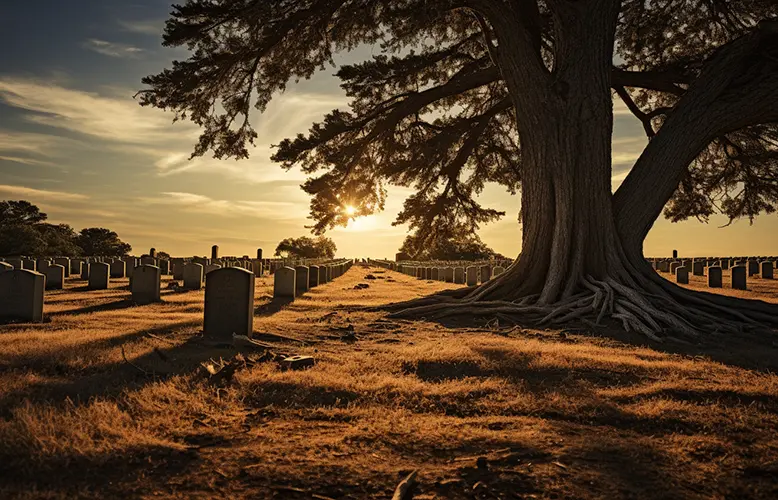Historical cemeteries have always seized the attention of many people. More than just final resting places, these sites serve as windows to history, legacy, and countless human stories. The hushed trails made of stone and the looming crypts encourage those passing by to stop and reflect on yesteryear, treasuring old memories and rediscovering lost tales.

Such graveyards stand as profound connectors to previous generations, emphasizing life’s fleeting nature and the perpetual essence of our heritage. While some people might find them somber, they recognize their appeal and see them as sanctuaries for thought, where history emerges to guide the current days.
The Deep Roots of Cemeteries in American History
The American area is speckled with diverse burial sites, each unfolding a distinct episode of the country’s chronicle. From the ancient burial techniques of Native Americans to the sacred grounds surrounding colonial churches, graveyards have held the key to America’s story.
- Pre-colonial traditions. Before the dawn of European settlers, the native tribes practiced distinct burial customs, including mound creations and burials in trees.
- Colonial era sanctuaries. As Europeans set foot, they introduced their own customs, evolving churchyards into pivotal community hubs and epicenters of societal activities.
- Garden burial grounds. With the rise of urban areas, there was a shift to garden cemeteries, prioritizing both beauty and communal involvement.
- Memorial sanctuaries. The past century witnessed the birth of memorial parks, showcasing evolving societal values and perceptions of death and remembrance.
These graveyards are living chronicles, revealing societal standards, spiritual leanings, and even past health challenges. The inscriptions on the gravestones narrate tales of affection, heartbreak, and heritage, silently urging those nearby to pay attention to them.
Focusing on America’s Prestigious Graveyards
The USA’s burial sites have consistently mirrored its multifaceted history and cultural tapestry. One of them is Arlington National Cemetery in Virginia. It’s more than a cemetery—it’s a national emblem, the final resting place for the most famous people, including ex-presidents, valiant soldiers, and impactful personas. This sacred place is vigilantly overseen by the Tomb of the Unknown Soldier.
St. Louis Cemetery No. 1 in New Orleans represents a maze of tombs and crypts. This place reflects the city’s vibrant culture. The tales of voodoo queens, the jazz rhythms, and the famous personalities interred here make it a vital chapter in the narrative of cemeteries in USA.
Nestled in Tarry Town, the Sleepy Hollow Cemetery is where literature meets history. The resting place of Washington Irving, it’s imbued with the legend of the Headless Horseman, making it an iconic landmark.
There’s also Mount Auburn Cemetery in Massachusetts. As America’s first garden cemetery, it broke away from the grim churchyard traditions, offering a serene, park-like ambiance for both the living and the departed.
The Art and Architecture
Historic cemeteries are not just repositories of the deceased but also galleries of artistic expression. Grand mausoleums stand tall, their intricate statues and carvings telling stories of the ones within. Architectural styles, from Gothic to Neoclassical, find representation in tombs and headstones. These styles are not just aesthetic choices; they reflect the socio-cultural beliefs of their times. Cemetery landscapes also echo architectural trends. Winding paths, ornamental trees, and tranquil ponds make these places idyllic, inviting peaceful contemplation amidst history.
Tales and Legends
Each gravestone holds a story, and every mausoleum enshrines an epic. Renowned figures from history find their final resting places in these areas, their legacies igniting the imagination of many.
Tales of phantoms and enigmas are plentiful. Hushed stories of ghostly figures and eerie tunes introduce a layer of mystery, transforming these burial grounds from mere resting spots to realms of enchantment.
While certain tales stand firm in factual history, others dance in the world of folklore. Nevertheless, they collectively magnify the allure of these hallowed sites, drawing inquisitive minds to venture further.
The Role of Cemeteries in Modern Society
Historical burial grounds have metamorphosed from simple internment sites to invaluable communal landmarks.
- Communal Hubs. They transcend their primary function as resting spaces. Contemporary graveyards often curate events spanning from educational walkthroughs to sunset musicals, emerging as epicenters of societal engagement.
- Windows to Yesteryears. Beyond the tombstones, they provide glimpses into bygone eras. Each memorial, each etching, imparts knowledge spanning history, artistry, and societal norms.
- Urban Oases. Nestled in cityscapes, these sites frequently act as verdant havens, granting city dwellers a break from urban sprawl and a moment to rekindle with the natural world.
- Centers for Art and Culture. Adorned with statues, mausoleums, and cultivated landscapes, graveyards have evolved into arenas for art admiration and cultural introspection, mirroring societal shifts and nuances across ages.
Safeguarding these historical sites is crucial. Issues like desecration, natural wear, and city expansion jeopardize their essence. Yet, with collective endeavors, these mute narrators can endure, sharing stories for eras ahead.

Conclusion
Historical graveyards are considered to be untapped gems. They serve as portals to the annals of time, and their tranquil lanes resonate with narratives from the past. As stewards of heritage, it’s our duty to value, safeguard, and perpetuate these chronicles. So, the next time anyone crosses paths with one, it is worth stopping and thinking about their magnitude.





